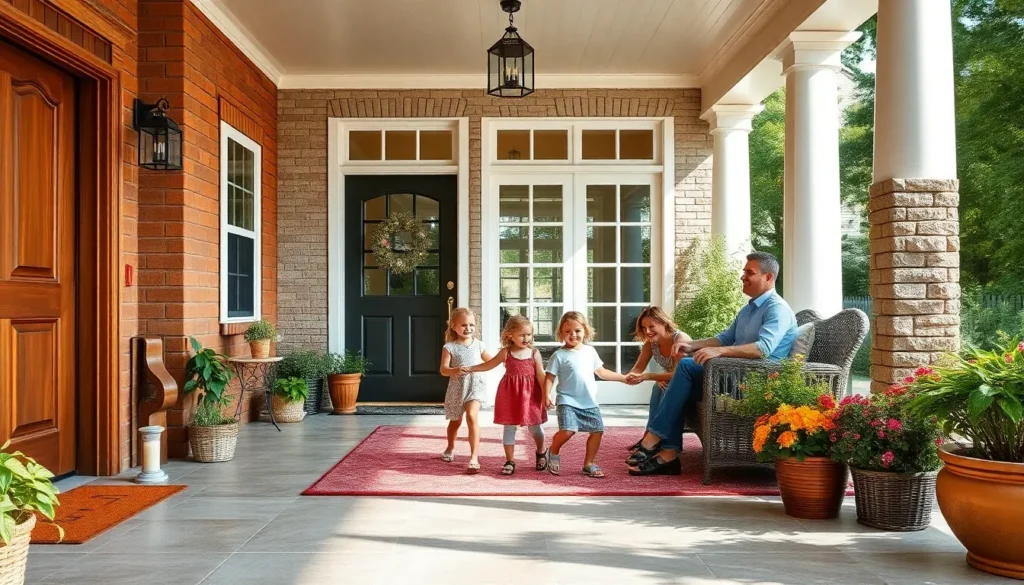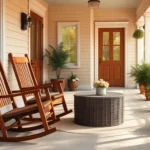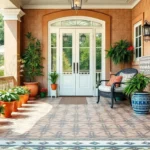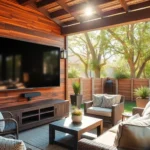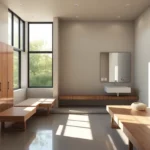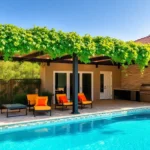Your front porch sets the stage for your home’s first impression, and choosing the right flooring can transform this space from ordinary to extraordinary. We’ve all walked up to a house and immediately noticed whether the porch feels welcoming or worn down – and that reaction often starts with what’s beneath our feet.
The perfect porch flooring balances durability with style while standing up to weather extremes and heavy foot traffic. From classic wood planks that exude timeless charm to modern composite materials that require minimal maintenance, today’s options offer something for every budget and aesthetic preference.
We’ll explore the most popular front porch flooring materials, weighing their pros and cons to help you make an well-informed choice. Whether you’re building new or renovating an existing porch, the right flooring choice can boost your home’s curb appeal and create an inviting entrance that welcomes guests and adds value to your property.
Concrete Front Porch Flooring Ideas
Concrete offers versatile front porch flooring answers that combine durability with aesthetic appeal. We’ll explore three popular concrete approaches that transform ordinary porches into stunning entryways.
Stamped Concrete Patterns
Stamped concrete creates the appearance of premium materials at a fraction of the cost. We can achieve realistic textures that mimic natural stone, brick, slate, or wood planks using specialized stamps and tools. Popular patterns include cobblestone, ashlar slate, herringbone brick, and wood grain designs that add visual interest to any front porch.
Installation involves pouring fresh concrete and pressing textured stamps into the surface before it fully cures. We recommend hiring experienced contractors since timing is critical for achieving professional results. The process typically costs $8 to $18 per square foot depending on pattern complexity and regional labor rates.
Maintenance requirements include periodic sealing every 2 to 3 years to protect against weather damage and color fading. Stamped concrete resists cracking better than individual pavers while providing similar aesthetic benefits.
Stained Concrete Finishes
Stained concrete transforms plain gray surfaces into rich, colorful floors that complement any architectural style. We can choose from acid based stains that create marbled, variegated effects or water based stains that offer consistent, uniform colors. Popular color options include earth tones like terra cotta, sage green, and warm browns that enhance natural surroundings.
Acid stains penetrate concrete pores and react chemically to create permanent, fade resistant colors. Water based alternatives provide broader color selections including blues, purples, and bright reds that aren’t possible with acid formulations. Application costs range from $2 to $8 per square foot depending on stain type and design complexity.
Surface preparation involves cleaning and etching the concrete to ensure proper stain penetration. We apply multiple thin coats rather than single heavy applications to achieve even coverage and prevent blotchy results.
Exposed Aggregate Options
Exposed aggregate reveals decorative stones embedded within concrete for natural texture and slip resistance. We can incorporate river rocks, crushed granite, colored glass, or recycled materials to create unique surface finishes. Common aggregate sizes range from 1/4 inch pea gravel to 3/4 inch stones that provide varying degrees of texture.
The process involves removing the top cement layer while concrete remains workable, exposing underlying aggregate materials. We use specialized tools and techniques including surface retarders, pressure washing, or hand brushing to achieve desired exposure levels. Installation costs typically range from $6 to $15 per square foot based on aggregate type and labor intensity.
Benefits include excellent traction in wet conditions and minimal maintenance requirements compared to smooth concrete surfaces. Exposed aggregate naturally hides minor stains and wear patterns while providing decades of reliable performance.
Wood Front Porch Flooring Ideas
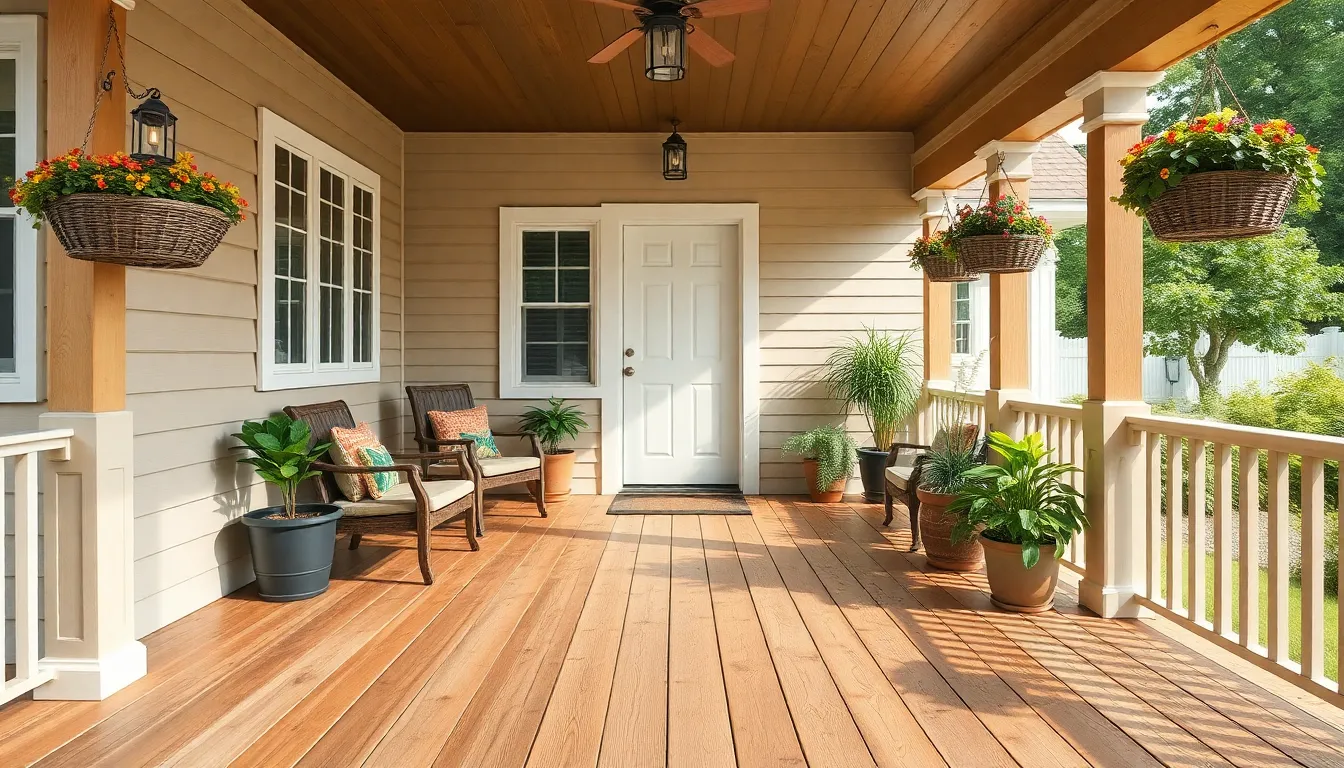
Natural wood remains a timeless choice for front porch flooring, offering warmth and classic appeal that complements virtually any home style. We’ll explore three popular wood options that provide different benefits and price points for your porch project.
Pressure-Treated Lumber
Budget conscious homeowners often choose pressure-treated lumber as their go-to porch flooring solution. This chemically treated pine offers excellent protection against rot, insects, and moisture damage without very costly. Cost effectiveness makes it widely accessible, though maintenance requirements include periodic sealing or staining to preserve its appearance.
Availability ranks as one of pressure-treated lumber’s biggest advantages. Most lumber yards stock this material year-round, making it easy to find for both new installations and repairs. Installation typically costs less than premium wood options, though the savings come with trade-offs in aesthetics and longevity.
Maintenance schedules for pressure-treated lumber require attention every 2-3 years. Sealing or staining becomes necessary to prevent weathering and maintain the wood’s protective qualities. Weather exposure gradually fades the treated appearance, requiring homeowners to stay proactive with upkeep.
Cedar and Redwood Options
Cedar flooring delivers premium performance with natural weather resistance that lasts up to 40 years. This softwood naturally repels insects, mold, and rot without requiring extensive chemical treatments. Installation costs range from $17 to $23 per square foot, reflecting its superior quality and durability.
Weather aging transforms cedar into an attractive gray patina over time. Homeowners can embrace this natural weathering process or maintain the original color with periodic treatment. Softness makes cedar more susceptible to dents and scratches compared to harder woods, requiring careful consideration for high-traffic areas.
Redwood offers exceptional durability with its distinctive reddish coloring. This premium option resists rot, mold, and insects naturally while providing 10-20 years of service with minimal maintenance. Pricing ranges from $18 to $22 per square foot, often requiring special orders due to its exotic classification.
Cutting characteristics favor redwood for clean, precise installations. But, its softer nature means scratches and dents occur more easily than with harder alternatives. Special ordering requirements can extend project timelines, making planning essential for redwood installations.
Composite Decking Materials
Modern composite materials blend wood fibers with plastic to create maintenance-free porch flooring. Leading brands like TimberTech and AZEK manufacture these boards to resist moisture, rot, insects, and splintering. Upfront costs exceed traditional wood options, but long-term savings emerge through eliminated maintenance requirements.
Cleaning becomes the only regular maintenance task for composite decking. No painting, staining, or sealing interrupts your schedule, freeing up time and reducing ongoing expenses. Multiple colors and finishes allow homeowners to achieve wood-like appearances without natural wood’s maintenance demands.
Texture provides a softer feel underfoot compared to traditional wood planks. Visual variety includes options that convincingly mimic various wood species and grain patterns. Durability surpasses most natural wood options, making composite materials an investment in long-term porch performance.
Natural Stone Front Porch Flooring Ideas
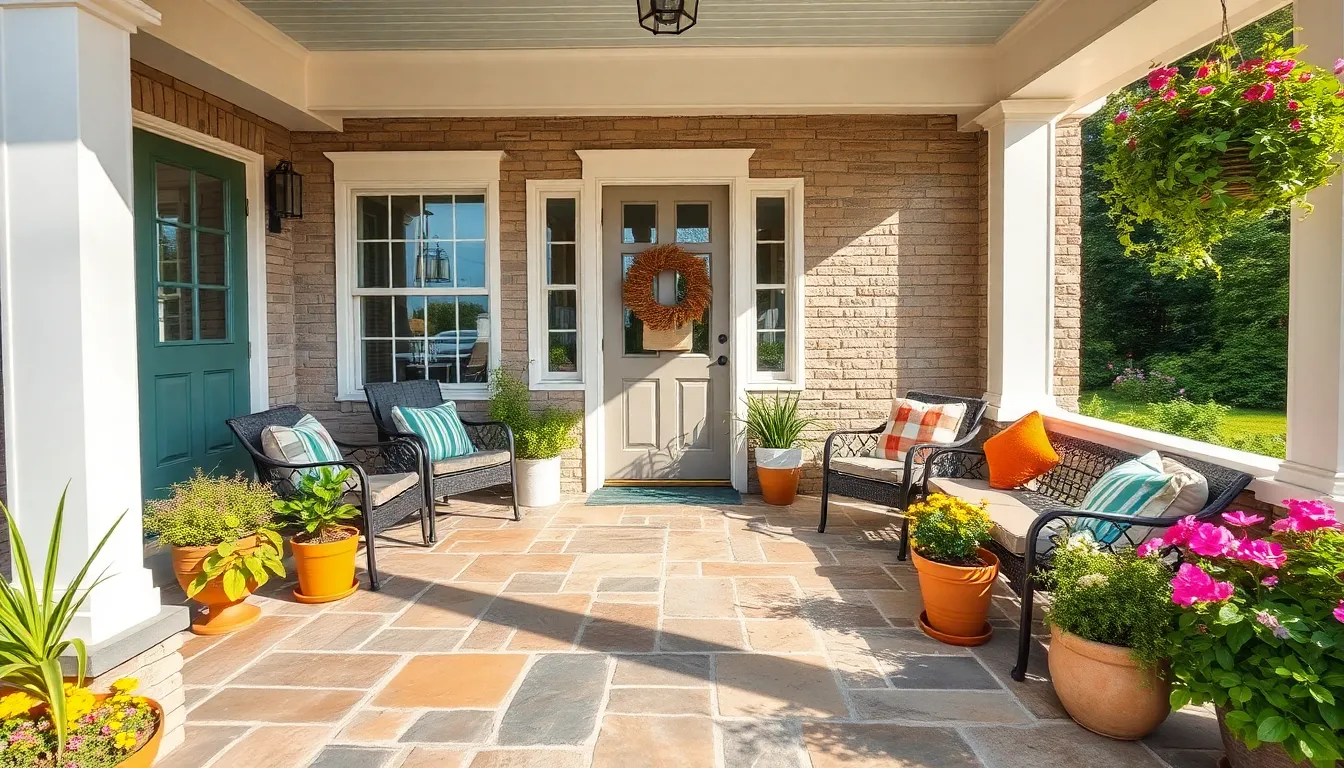
Natural stone flooring elevates front porches with unmatched durability and timeless elegance. Stone materials withstand weather conditions better than wood while requiring less maintenance over time.
Slate Flooring Installation
Slate transforms front porches with its natural neutral tones and sophisticated texture that resembles traditional kitchen tiles but offers superior outdoor durability. We recommend slate flagstone for its rustic yet polished appearance that complements white accents beautifully. Installing slate requires proper subflooring to support the stone’s weight, especially when retrofitting existing porches.
Slate installation benefits include:
- Slip resistant surface for enhanced safety
- Available in irregular flagstone pieces or uniform tile formats
- Natural elegance that pairs well with colorful porch decor
- Weather resistant properties when properly sealed
Sealing protects slate from weathering and maintains its long term durability. Regular maintenance involves resealing every few years to preserve the stone’s appearance and protective qualities.
Flagstone Pattern Designs
Flagstone creates stunning natural mosaic effects through large, flat pieces cut into irregular shapes. We love how flagstone patterns bring rustic charm to front porches while offering versatility in design layouts. Common flagstone materials include slate, sandstone, and limestone, each providing unique color variations and textures.
Popular flagstone pattern options:
- Random ashlar patterns for organic, natural appearance
- Coursed ashlar designs for more structured layouts
- Crazy paving patterns using various sized pieces
- Border designs combining different flagstone types
Flagstone patios and porches develop warm, earthy appeal that enhances outdoor living spaces. Properly finished flagstone surfaces provide excellent slip resistance, making them ideal for high traffic porch areas.
Limestone and Travertine Options
Limestone and travertine tiles deliver luxurious, timeless aesthetics to front porch flooring with their softer textures and warm tones ranging from beige to cream. We find these stones particularly effective at improving porch elegance while maintaining natural character that complements various architectural styles.
| Stone Type | Surface Characteristics | Color Range | Best Applications |
|---|---|---|---|
| Limestone | Smooth with subtle patterns | Beige to light gray | Refined, classic porches |
| Travertine | Natural pits and textures | Cream to tan | Luxury outdoor spaces |
Limestone offers smooth surfaces with subtle natural patterning that creates refined porch aesthetics perfect for traditional and contemporary homes. Travertine features distinctive natural pits and textures that add character, with tumbled travertine being especially popular for its slip resistance and aged appearance.
Both stones require periodic sealing to protect against weather damage and staining. Installing these premium stones works best with proper drainage systems and professional installation to ensure longevity and performance in outdoor environments.
Tile Front Porch Flooring Ideas
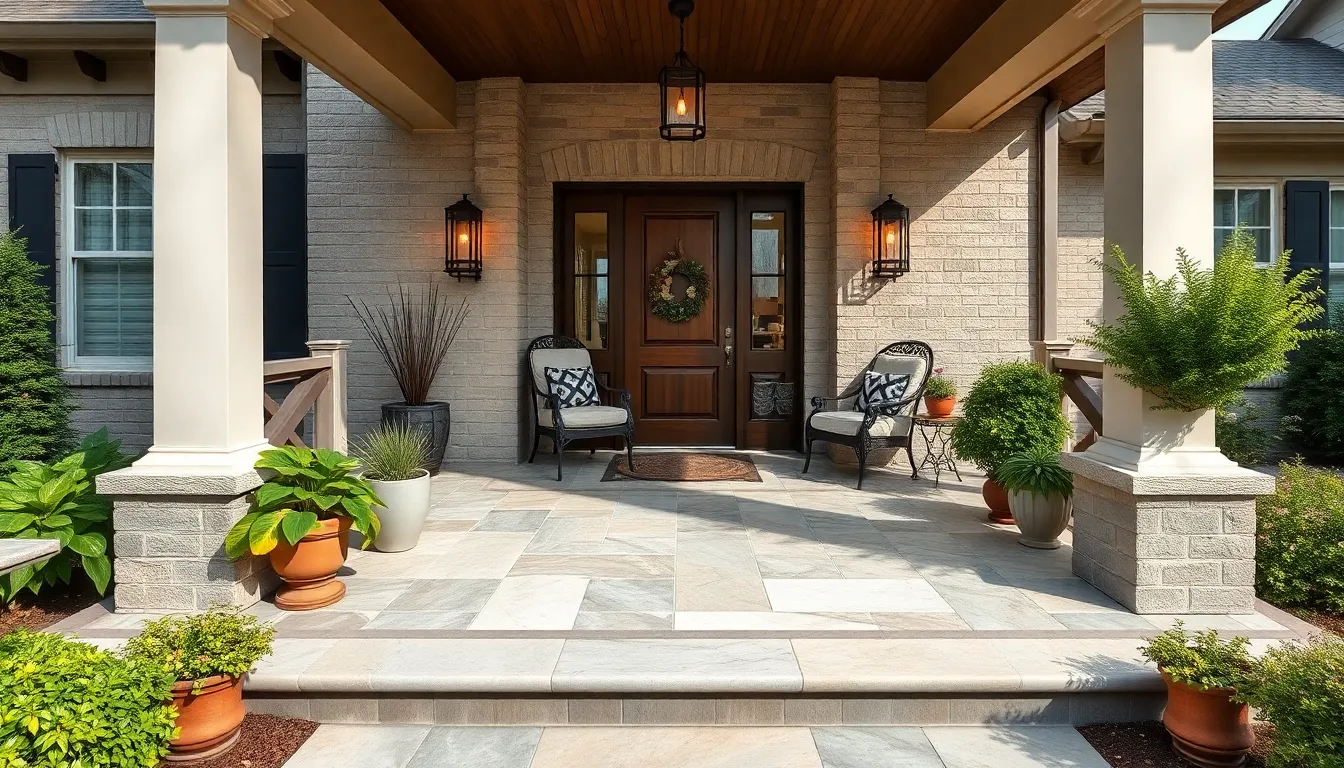
Tile flooring continues to gain popularity among homeowners who want durability without sacrificing style for their front porches. We’ve explored various materials, and now we’ll examine three exceptional tile options that deliver both performance and aesthetic appeal.
Porcelain Tile Durability
Porcelain tile stands out as an excellent choice for front porches due to its exceptional durability and resistance to outdoor conditions. This dense, hard material resists scratches, stains, and heavy foot traffic better than most alternatives. Porcelain tiles rated for exterior use can withstand temperature changes and moisture without compromising their structural integrity.
We appreciate how porcelain offers a refined, polished appearance while maintaining practical benefits. Installation requires proper subflooring, but the long-term performance justifies the initial investment. Maintenance involves simple cleaning with standard porch cleaning answers, and the material won’t fade or deteriorate under constant sun exposure.
Natural Stone Tile Varieties
Natural stone tiles provide three outstanding options for front porch flooring: travertine, flagstone, and slate. Travertine delivers a smooth, sophisticated finish that creates an elegant porch atmosphere while handling heavy foot traffic effectively. Flagstone presents a rustic, natural appearance perfect for informal outdoor spaces and offers exceptional weather resistance.
Slate tiles provide natural slip resistance and come in various colors and textures for unique aesthetic combinations. These materials withstand moisture and temperature changes exceptionally well, making them ideal for outdoor porch applications. Sealing becomes necessary to prevent staining, but the low maintenance requirements make natural stone tiles practical long-term investments.
Ceramic Tile Weather Resistance
Ceramic tile presents a more budget-friendly option, though it requires careful selection for outdoor porch use. This material’s porous nature makes it less weather-resistant than porcelain, particularly in freeze-thaw climates. Ceramic tiles need exact outdoor glazing or treatment to prevent moisture damage and ensure longevity.
Proper installation and sealing are essential for ceramic tile performance on front porches. We recommend choosing ceramic tiles specifically rated for exterior applications to avoid weather-related problems. The variety of styles and finishes available makes ceramic attractive, but durability considerations should guide your final decision based on your local climate conditions.
Brick Front Porch Flooring Ideas
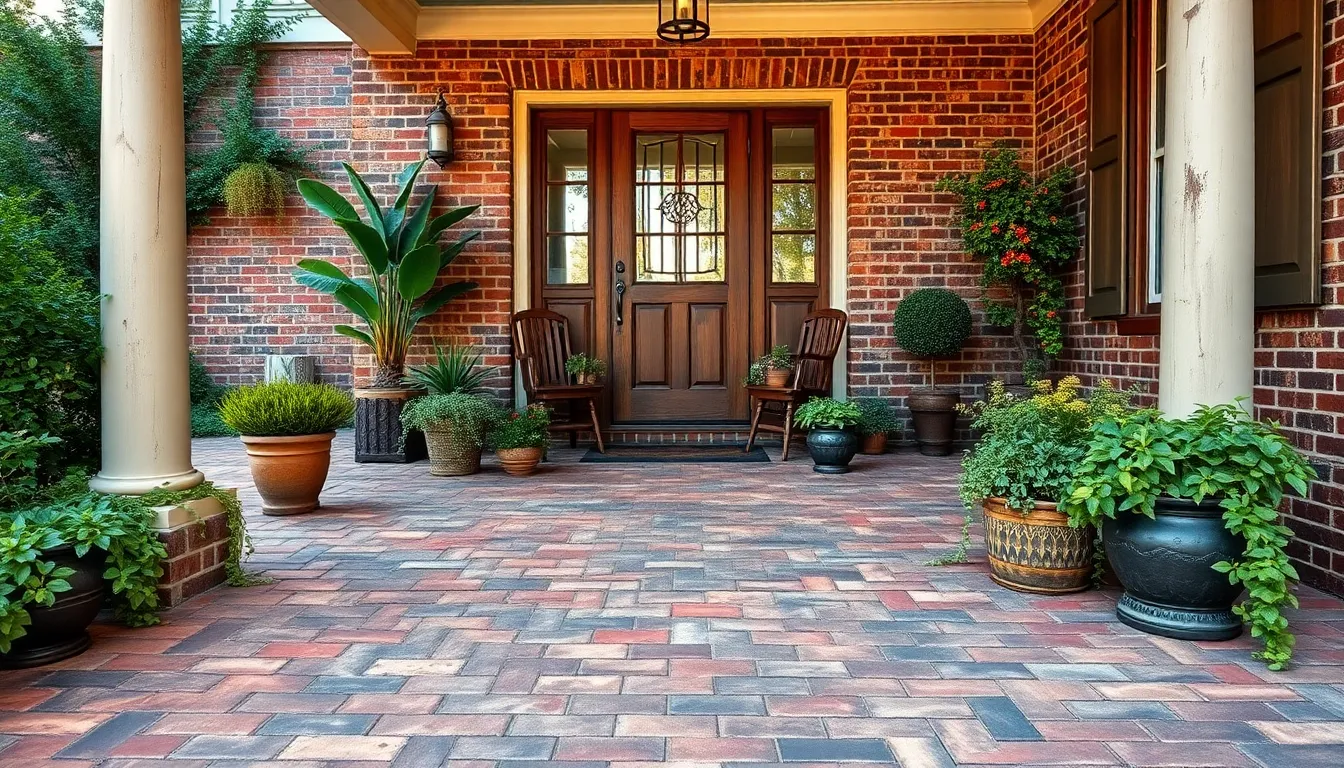
We often find brick to be the perfect balance of classic charm and modern durability for front porch flooring. This timeless material offers exceptional longevity while creating an inviting entrance that complements various architectural styles.
Traditional Brick Patterns
Traditional brick patterns transform your front porch into a sophisticated entrance that never goes out of style. We recommend exploring popular layouts like running bond, herringbone, basket weave, and soldier courses to create visual interest and texture underfoot. Each pattern offers unique benefits – running bond provides clean lines perfect for colonial homes, while herringbone adds elegant complexity to craftsman-style porches.
Patterns can be customized to match your home’s architectural character, from simple geometric designs to intricate motifs. We’ve seen how these layouts naturally provide slip resistance through their textured surfaces, making them both beautiful and functional. Different brick orientations also allow you to control the visual flow of your porch space, directing the eye toward your front door or highlighting exact architectural features.
Reclaimed Brick Character
Reclaimed brick flooring brings authentic history and weathered charm to your front porch that new materials simply can’t replicate. We love how these materials showcase natural patina, color variations, and slight imperfections that tell a story while creating warmth and character. Each reclaimed brick carries unique weathering patterns that add rustic appeal to any home style.
Choosing reclaimed materials represents an eco-friendly approach to porch renovation, recycling authentic materials with genuine texture and aging. We find these bricks pair beautifully with natural landscaping elements, wrought iron details, and wood accents to create cohesive outdoor spaces. Their weathered appearance eliminates concerns about new materials looking too pristine or out of place in established neighborhoods.
Brick Pavers Installation
Brick pavers offer the most versatile and straightforward installation option for front porch flooring projects. We recommend these pre-cut units because they can be installed over concrete bases or compacted sand, providing excellent drainage and long-term durability. Installation flexibility allows for both simple patterns and intricate designs depending on your budget and complexity preferences.
Proper installation requires establishing a stable base, ensuring thorough compaction, and applying protective sealing to guard against weather damage and staining. We’ve found that paver systems accommodate various pattern arrangements while maintaining structural integrity over time. Professional installation typically includes proper grading for water drainage, which prevents common issues like pooling water or frost damage that can compromise your investment.
Paint and Stain Front Porch Flooring Ideas
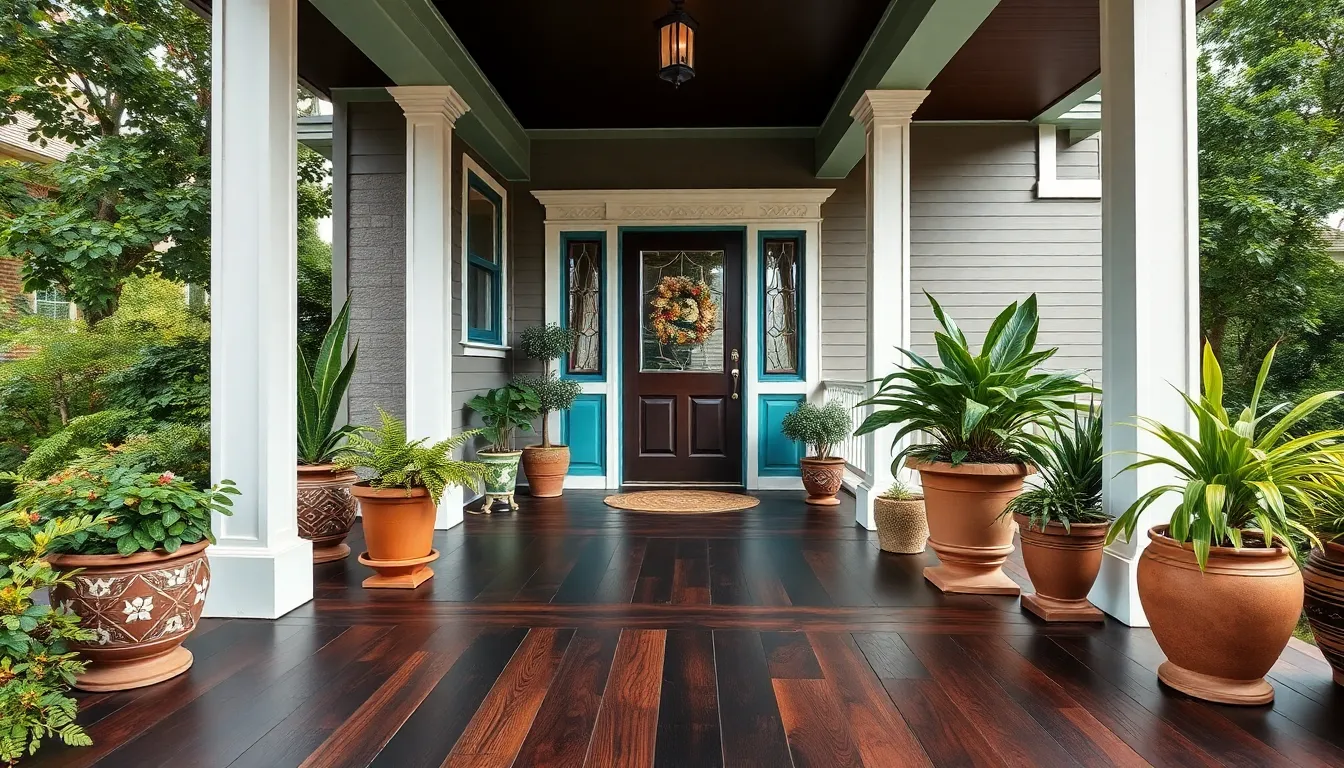
Transform your existing front porch flooring with creative paint and stain answers that deliver impressive results without replacing materials. These budget-friendly options breathe new life into concrete and wood surfaces while providing durability and visual appeal.
Painted Concrete Designs
Painted concrete creates a sleek, refreshed appearance that withstands weather conditions while offering endless customization possibilities. We recommend using non-slip outdoor paint to ensure safety while maintaining the aesthetic appeal of your decorative concrete surface.
Popular Painted Concrete Techniques:
- Stenciled patterns mimic expensive tile or brick surfaces at a fraction of the cost
- Geometric designs including hexagons and diamonds suit modern and mid-century home styles
- Faux finishes replicate natural stone textures with specialized painting techniques
- Solid colors provide clean, minimalist looks that complement contemporary architecture
Concrete’s versatility allows homeowners to achieve industrial, modern, or traditional aesthetics through strategic color choices and application methods. Weather-resistant paint formulations ensure your decorative concrete maintains its appearance through seasonal changes while requiring minimal maintenance compared to other flooring options.
Wood Stain Color Options
Wood stain enhances natural grain patterns while protecting your front porch flooring from moisture and UV damage. Proper sealing after staining maintains durability and prevents deterioration from weather exposure.
Stain Color Categories:
| Stain Type | Color Range | Best For |
|---|---|---|
| Clear/Natural | Natural wood tones | Showcasing premium wood grain |
| Light Stains | Honey, golden brown | Brightening smaller porch spaces |
| Medium Stains | Rich browns, cherry | Balancing warmth with visibility |
| Dark Stains | Deep browns, grays, black | Modern aesthetics and rich appearance |
Semi-transparent stains strike the perfect balance by adding color while preserving the wood’s natural texture visibility. Lighter stain colors brighten confined porch areas, while darker options add warmth and sophistication to larger spaces. We suggest testing stain colors on hidden wood sections before full application to ensure desired results.
Decorative Paint Techniques
Decorative paint techniques transform ordinary porch surfaces into stunning focal points that reflect your personal style. These methods work effectively on both concrete and wood surfaces when combined with appropriate weatherproof sealers.
Essential Decorative Painting Methods:
- Stenciling applies intricate motifs and tile-like patterns for detailed visual interest
- Striping creates bold borders and classic linear designs
- Sponging produces textured, layered effects through dabbing techniques
- Rag rolling achieves sophisticated depth with rolled fabric application
- Chevron patterns deliver contemporary geometric appeal
Color selection ranges from neutral tones that complement existing architecture to vibrant accent colors that create dramatic curb appeal. We recommend coordinating decorative paint colors with your home’s exterior palette and surrounding industry elements for cohesive design integration.
Pattern complexity can vary from simple geometric shapes to elaborate medallion designs depending on your skill level and desired maintenance requirements. Professional application ensures consistent results, while DIY approaches allow creative expression with proper preparation and quality materials.
Budget-Friendly Front Porch Flooring Ideas
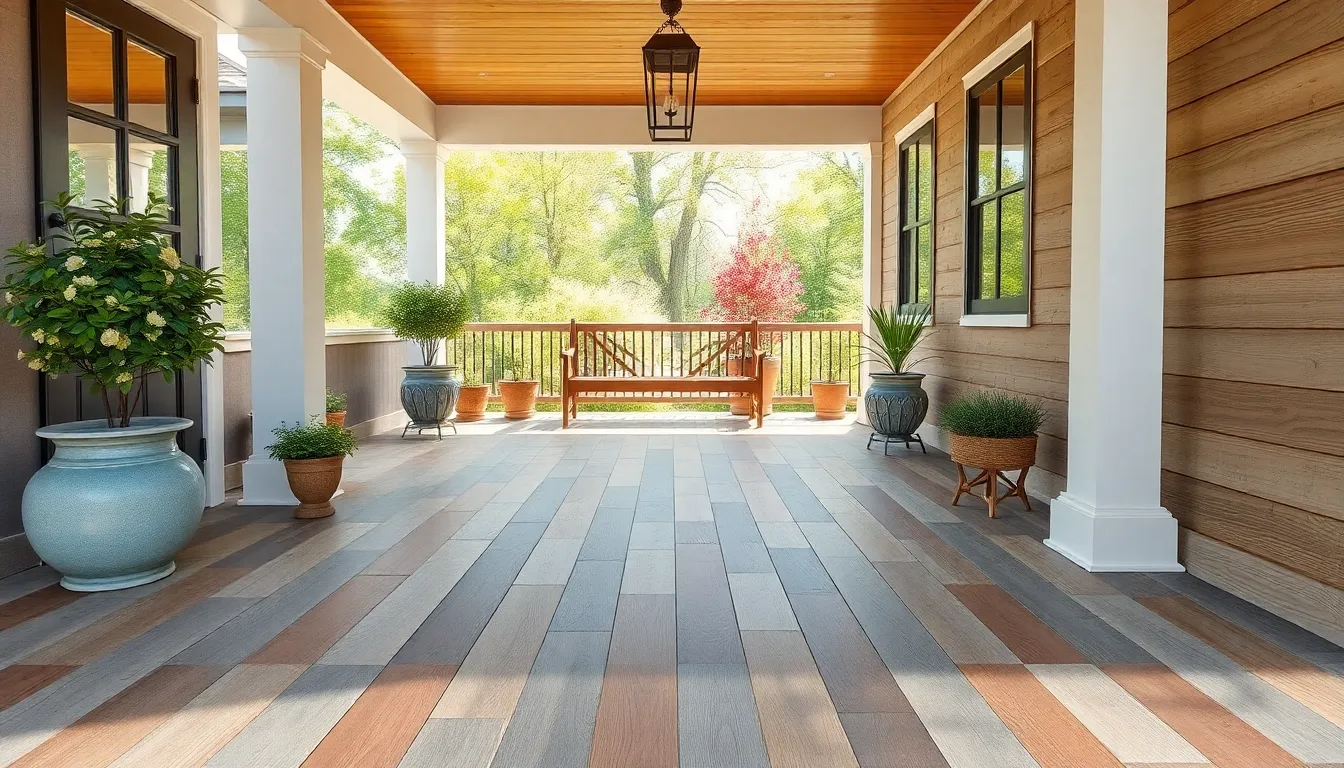
Creating beautiful front porch flooring doesn’t require very costly. We’ve discovered several affordable approaches that deliver impressive results without compromising quality or style.
DIY Installation Methods
Peel and stick vinyl tiles transform front porches with minimal effort and maximum savings. We simply clean the existing surface, peel off the backing, and press each tile into place for an instant waterproof floor that mimics wood or stone appearances.
Interlocking PVC patio tiles snap together without any adhesives or nails required. These Staylock perforated tiles float over existing subfloors while providing excellent drainage, waterproof protection, and non-slip surfaces that resist oil and acid damage.
Wood frame construction over concrete creates warmth and character using affordable pressure-treated 2×4 lumber. We build sleeper joists attached directly to the concrete base, then install wood boards on top that can be painted or stained to match our home’s aesthetic.
Tile installation delivers professional results when we follow proper preparation steps. Applying a waterproof membrane underneath ceramic or porcelain tiles ensures long-lasting durability, while careful spacing and grouting create polished finishes.
Cost-Effective Material Choices
| Material Type | Cost Per Sq Ft | Key Benefits |
|---|---|---|
| Peel & Stick Vinyl | $2-4 | Easy installation, waterproof, variety of styles |
| PVC Patio Tiles | $3.50 | No-glue installation, drainage holes, slip-resistant |
| Pressure-Treated Wood | $3-6 | Natural appearance, paintable, readily available |
| Ceramic Tiles | $1-5 | Budget-friendly, many designs, durable |
Pressure-treated lumber offers the most affordable wood option while providing decent weather resistance. We choose this material for its widespread availability and ability to accept stains or paint finishes.
Ceramic and porcelain tiles deliver excellent value with countless design possibilities. These materials resist moisture and temperature changes better than many alternatives while staying within tight budgets.
Vinyl flooring options provide waterproof protection with realistic textures that fool the eye. Modern vinyl planks replicate hardwood grain patterns so convincingly that guests often mistake them for real wood.
Repurposed Flooring Answers
Refurbished wood boards from previous projects create unique character floors with minimal investment. We sand, seal, and refinish old lumber to achieve custom appearances that tell stories while saving money.
Leftover tiles from indoor renovations extend their usefulness to outdoor spaces. Rather than storing unused materials, we calculate square footage needs and repurpose excess ceramic, porcelain, or natural stone tiles for cohesive design themes.
Reclaimed materials from demolition projects offer authentic weathered appearances that new products can’t replicate. We carefully inspect salvaged wood for structural integrity before cleaning and sealing boards for porch applications.
Creative combinations of different repurposed materials create interesting patterns and focal points. Mixing reclaimed brick borders with refurbished wood centers or combining leftover stone tiles with painted concrete sections produces distinctive custom looks.
Weather-Resistant Front Porch Flooring Ideas

When it comes to protecting your front porch investment, weather resistance is crucial for maintaining both beauty and functionality year after year. We’ll explore the most durable flooring options that can withstand nature’s challenges while keeping your porch safe and stylish.
Anti-Slip Surface Treatments
Rubber flooring naturally provides excellent slip resistance, making it one of the safest choices for outdoor porches where traction is essential. This material offers water resistance alongside its anti-slip properties, though it typically has a shorter lifespan compared to stone or concrete options.
Textured natural stones like slate deliver both non-slip surfaces and impressive water resistance in a single solution. Slate’s natural texture creates grip underfoot while its composition naturally repels moisture, making it ideal for wet weather conditions.
Anti-slip coatings can transform existing wood flooring into safer surfaces through specialized treatments. Polyguard’s waterproof balcony membrane, for example, adds both slip resistance and waterproofing protection to underlying wood materials, extending their lifespan significantly.
Drainage Consideration Features
Waterproof membrane systems like Polyguard’s Balconyguard™ allow proper water drainage while protecting the structural materials underneath. These systems prevent water damage by directing moisture away from vulnerable areas while maintaining the integrity of your porch foundation.
Interlocking slat tiles help excellent drainage through their innovative design featuring gaps between slats. Pure Garden polypropylene tiles exemplify this approach, preventing water pooling that can lead to slip hazards and material deterioration.
Sloped installation ensures natural water runoff, which minimizes both water damage and safety concerns. Proper grading during installation creates a gentle slope that directs water away from your home’s foundation while maintaining an attractive appearance.
Climate-Exact Material Selection
Cold climate materials require special consideration for freeze-thaw cycles and snow load. Sandstone and slate flooring provide excellent insulation properties while resisting damage from ice and snow, making them ideal choices for northern regions.
Warm climate answers focus on heat resistance and UV protection to prevent fading and cracking. Granite floors excel in hot conditions, offering heat resistance along with versatile color options that won’t fade under intense sunlight.
Variable climate adaptability calls for materials that handle both moisture and temperature extremes effectively. Waterproof vinyl flooring and polymer-capped boards, like TimberTech’s polymer-capped decking, withstand UV exposure while providing moisture protection throughout changing seasons.
Humidity resistant options include composite wood materials made from bamboo, wood fibers, and recyclable resins. These materials resist decay from moisture while offering sustainable choices perfect for wet climates where traditional wood might struggle.
Conclusion
We’ve explored an extensive range of front porch flooring options that can transform your home’s entrance into a stunning focal point. From classic natural stone and timeless wood to modern composite materials and creative paint techniques each choice offers unique benefits for different budgets and design preferences.
The key to selecting the perfect front porch flooring lies in balancing your aesthetic vision with practical considerations like climate weather resistance and maintenance requirements. Whether you’re drawn to the elegance of travertine the warmth of cedar or the affordability of painted concrete there’s a solution that’ll meet your exact needs.
Remember that proper installation and drainage are crucial for long-term success regardless of which material you choose. With the right planning and execution your new front porch flooring will provide years of beauty and functionality while improving your home’s overall value and curb appeal.
Frequently Asked Questions
What are the best materials for front porch flooring?
The best materials include concrete (stamped, stained, or exposed aggregate), natural wood (cedar, redwood, pressure-treated lumber), composite decking, natural stone (slate, travertine, flagstone), tile (porcelain, ceramic), and brick. Each offers different benefits in terms of durability, aesthetics, and maintenance requirements. Your choice should depend on your budget, climate, and style preferences.
How much does front porch flooring typically cost?
Costs vary significantly by material. Pressure-treated lumber and ceramic tiles are budget-friendly options. Mid-range choices include composite decking and porcelain tiles. Premium materials like natural stone, cedar, and redwood cost more but offer superior durability and aesthetics. DIY installation can reduce costs, while professional installation ensures proper drainage and longevity.
Is concrete a good choice for front porch flooring?
Yes, concrete is excellent for front porches. Stamped concrete mimics premium materials at lower costs, stained concrete offers vibrant color options, and exposed aggregate provides slip resistance and texture. Concrete is durable, weather-resistant, and requires minimal maintenance when properly sealed. It’s also budget-friendly and can be customized with various patterns and colors.
What wood options work best for front porch flooring?
Popular wood choices include pressure-treated lumber (budget-friendly but requires maintenance), cedar (naturally weather-resistant with long lifespan), and redwood (exceptional durability with distinctive appearance). All wood options need regular maintenance including staining or sealing to protect against moisture, UV damage, and weathering. Proper installation and drainage are crucial for longevity.
Are composite materials worth considering for front porch flooring?
Absolutely. Composite decking combines wood fibers and plastic for a maintenance-free option that offers excellent durability without the upkeep demands of natural wood. It resists moisture, insects, and UV damage while providing various aesthetic choices. Though initially more expensive than pressure-treated lumber, composites save money long-term through reduced maintenance requirements.
How do I choose flooring for different climate conditions?
For cold climates, choose sandstone and slate for freeze-thaw resistance. Warm climates benefit from granite and porcelain tiles that handle heat and UV exposure. Variable climates work well with composite materials that adapt to temperature changes. Humid areas need moisture-resistant options like sealed natural stone or composite materials that resist decay and mold.
What maintenance do different porch flooring materials require?
Concrete needs periodic sealing and cleaning. Wood requires annual staining or sealing plus regular cleaning. Natural stone needs sealing every 1-3 years and gentle cleaning. Tile requires grout maintenance and occasional sealing. Composite materials need only regular cleaning. Brick requires occasional sealing and joint maintenance. Proper drainage is essential for all materials.
Can I install front porch flooring myself?
Many options are DIY-friendly, including peel-and-stick vinyl tiles, interlocking PVC tiles, and some wood installations. However, materials requiring proper drainage, subflooring, or specialized installation (like natural stone or stamped concrete) benefit from professional installation. Consider your skill level, available time, and the importance of proper installation for long-term performance.
How can I make my front porch flooring slip-resistant?
Choose textured materials like exposed aggregate concrete, natural stone with rough surfaces, or add anti-slip coatings to existing surfaces. Rubber flooring provides excellent slip resistance. Proper drainage prevents water pooling, which reduces slip hazards. Avoid smooth surfaces in wet climates, and consider adding texture through staining techniques or non-slip additives.
What’s the most budget-friendly front porch flooring option?
Pressure-treated lumber and ceramic tiles are the most affordable options. DIY installation significantly reduces costs. Repurposed materials like reclaimed brick or leftover tiles offer unique looks at lower prices. Painted concrete with decorative techniques provides customization at minimal cost. Peel-and-stick vinyl tiles offer easy, inexpensive installation for covered porches.

